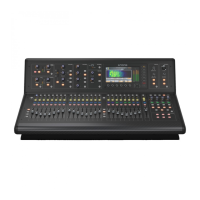86 M32 - Digital Console User Manual 87
Gated Reverb
This eect was originally achieved by combining a reverb with a noise gate. Our gated reverb creates the same impression
by a special shaping of the reverb tail. Gated Reverb is especially eective for creating a 1980’s-style snare sound, or to
enlarge the presence of a kick drum. Inspired by the Lexicon 300/480L.
PRE DELAY controls the amount of time before the reverberation is heard following the source signal. DECAY controls the
amount of time it takes for the reverb to dissipate. ATTACK controls how fast the reection density builds up. DENSITY
shapes the reverb decay tail. The higher the density, the greater the number of sound reections. SPREAD controls how
the reection is distributed through the reverb envelope. The LO CUT rotary control sets the frequency beneath which the
source signal will not pass through the reverb. HiSvFr / HiSvGn rotary controls adjust a high-shelving lter and the input
of the reverb eect. DIFF(usion) controls the initial reection density.
Vintage Room
Vintage Room simulates the reverberation that occurs when sound is recorded in a small room. When you want to add a
bit of warmth and just a touch of reverb, the M32’s Vintage Room breathes life into close-miked guitar and drum tracks.
Inspired by the Quantec QRS.
The VU meter displays the input and output levels. Set the early reection times for the left and right channel with ER
DELAY L and ER DELAY R. ER LEVEL sets the loudness of the early reection level. REV DELAY controls the amount of
time before the reverberation is heard following the source signal. HI/LOW MULTIPLY adjusts the decay time of the high
and bass frequencies. TIME shows the duration of the reverb eect. ROOM SIZE adjusts the size of the room eect being
created incrementally from small to large. HIGH CUT sets the frequency above which the source signal does not pass
through the reverb. DENSITY manipulates the reection density in the simulated room. (This slightly changes the reverb
decay time.) LOW CUT sets the frequency below which the source signal does not pass through the reverb.
Reverse Reverb
Reverse Reverb takes the trail of a reverb, turns it around, and places it in front of the sound source.. Use the swelling cre-
scendo of the Reverse Reverb to add an ethereal quality to vocal and snare drum tracks. Inspired by the Lexicon 300/480L.
Adjusting the PRE DELAY rotary control adds up to 200 milliseconds before the reverb follows the source signal. The
DECAY rotary control adjusts the time it takes for the reverb to completely dissipate. RISE controls how quickly the eect
builds up. DIFF(usion) controls the initial reection density. SPREAD controls how the reection is distributed through
the reverb envelope. The LO CUT rotary control sets the frequency beneath which the source signal will not pass through
the reverb. HiSvFr / HiSvGn rotary controls adjust a high-shelving lter and the input of the reverb eect. DIFF(usion)
controls the initial reection density.
Stereo Delay
Stereo Delay provides independent control of left and right delay (echo) times, and features high- and low-pass lters
for enhanced tone-shaping of the delayed signals. Use the Stereo Delay to give your mono signals a wide presence in the
stereo eld.
The MIX control lets you blend the source signal and the delayed signal. TIME adjusts the master delay time up to three
seconds. LO CUT adjusts the low frequency cut, allowing lower frequencies to remain unaected by the delay. HI CUT ad-
justs the high frequency cut, allowing higher frequencies to remain unaected by the delay. FACTOR L sets the delay time
on the left channel to rhythmic fractions of the master delay time. FACTOR R sets the delay time on the right channel to
rhythmic fractions of the master delay time. OFFSET LR adds a delay dierence between the left and right delayed signals.
The FEED LO CUT/HI CUT adjusts lters in the feedback paths. FEED L and FEED R control the amount of feedback for the
left and right channels. MODE selects the feedback mode:
• ST sets normal feedback for both channels
• X crosses feedback between left and right channels
• M creates a mono mix within the feedback chain.
www.theaudiospecialists.eu

